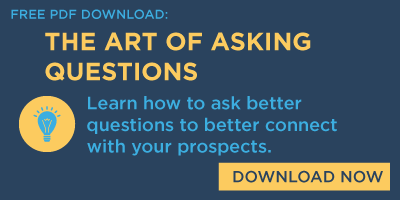 Wouldn’t it be nice if you had a list of ten surefire questions you could ask during a needs analysis meeting that would lead directly to cash? That would be sweet… show up, ask the questions, and leave with an order!
Wouldn’t it be nice if you had a list of ten surefire questions you could ask during a needs analysis meeting that would lead directly to cash? That would be sweet… show up, ask the questions, and leave with an order!
Too bad that list does not exist. There is a list of guidelines to follow that will elevate your questions and your method of questioning to a higher level… perhaps to Rembrandt level. Salespeople can reach this level by perfecting the art of asking questions!
Here are 8 surefire tactics to help polish your question-asking skills:
1. Ask Questions Informed By Insights
Ask questions informed by what you have uncovered during your valid business reason development and needs analysis meeting preparation. Don’t show up and ask questions that you can find the answers to before the conversation via a Google search or visit to the place of business. Here’s a great example of the type of question to ask, “I have read about the impact of review sites and on-demand services on the home services business. I know you are using Home Advisor and Thumbtack. What would you say are the pros and cons of these sites?”
2. Start Wide, Then Go Narrow
You might start with a wide question such as, “What area of the business did you expect stronger growth than you are seeing this year?” And then, based on their response, go narrow and ask, “Have you identified the top 2-3 things holding you back?”
3. Ask Mostly Open-Ended Questions
Most of your questions should be questions that can’t be answered with a simple yes or no. Open-ended questions tend to lead the prospect or client to give more detail.
4. Ask Closed-Ended Questions to Narrow Down and Add Focus
We say most of your questions should be open-ended, but not all. At some point, you will want to use a few clarifying questions to confirm your understanding of what they said. Here are some examples.
Open-ended: “What have you found is the best way to layer your Social media, so that it works in conjunction with your Search?”
Closed-ended: “Do you feel like your Search and Social spending are working together effectively so that 1 + 1 = 3?
5. Listen Actively and Take Notes
The art of asking questions also includes listening. You can’t be actively listening if you’re busy forming your next question while the prospect is still answering one. A combination of eye contact and taking notes is best. Allowing a short pause when the prospect stops talking gives you time to digest what they just said, and it gives the prospect time to think too.
6. Go Fishing for Trouble
Searching for challenges, growth opportunities, and problems you can help solve, could be thought of as fishing for trouble. You should begin with the type of questions that a professional colleague would ask, like these:
- As manager of this department, what key areas are you responsible for?
- How does your company measure performance?
- What’s the biggest obstacle to reaching your revenue goals?
As you fish deeper, you might ask:
- What kinds of problems are you having in your business today, that just a few years ago did not exist?
- Where do you believe you are most vulnerable to an attack from one of your competitors?
- Is there a segment of your industry that is expanding, and you’re not getting your fair share of that growth?
Fishing for trouble can bring you into sensitive topic areas, so next we’ll look at how to keep the rapport comfortable while asking those type of questions.
7. Set-Up, Then Follow-Up on Sensitive Topics
When asking more direct questions and going into sensitive topics, it’s best to first set-up the question, and then follow-up. For example, you may set-up a question by asking, “If your energy drink sales go well, how might that enhance your retail relationships?” Then follow up with, “And if energy drink sales were to fall below expectations, what impact would that have on your retail relationships?"
It is a good idea to ask these types of questions and fishing for trouble questions after you’ve had some dialogue and relationship tension has transferred to task tension. Avoid starting a needs analysis with these types of questions, unless you want the meeting to end before it begins!
8. Remember To Ask, Listen, Ask
I’ve given you several ways to master the art of asking questions for your needs analysis meetings. This last one is easy to remember, and you can work in all the others as you use it.
If you’ve asked a question, be sure to stop and really listen to the answer before asking the follow-up question. And when you ask that next question, use some of the ideas you’ve learned in this course. When in doubt, sometimes a good follow-up question is simply to say, “Tell me more.”
Are You a Rembrandt or Just Another Seller?
Different types of questions lead to different conversations and will vary depending on where you are in the relationship with a new business prospect or customer. You should ask your questions in a way that will uncover the prospect or client’s desired business results. Be sure to zero in on the most important assignment that leads to cash! This process will make you feel like the Rembrandt of the needs analysis.



